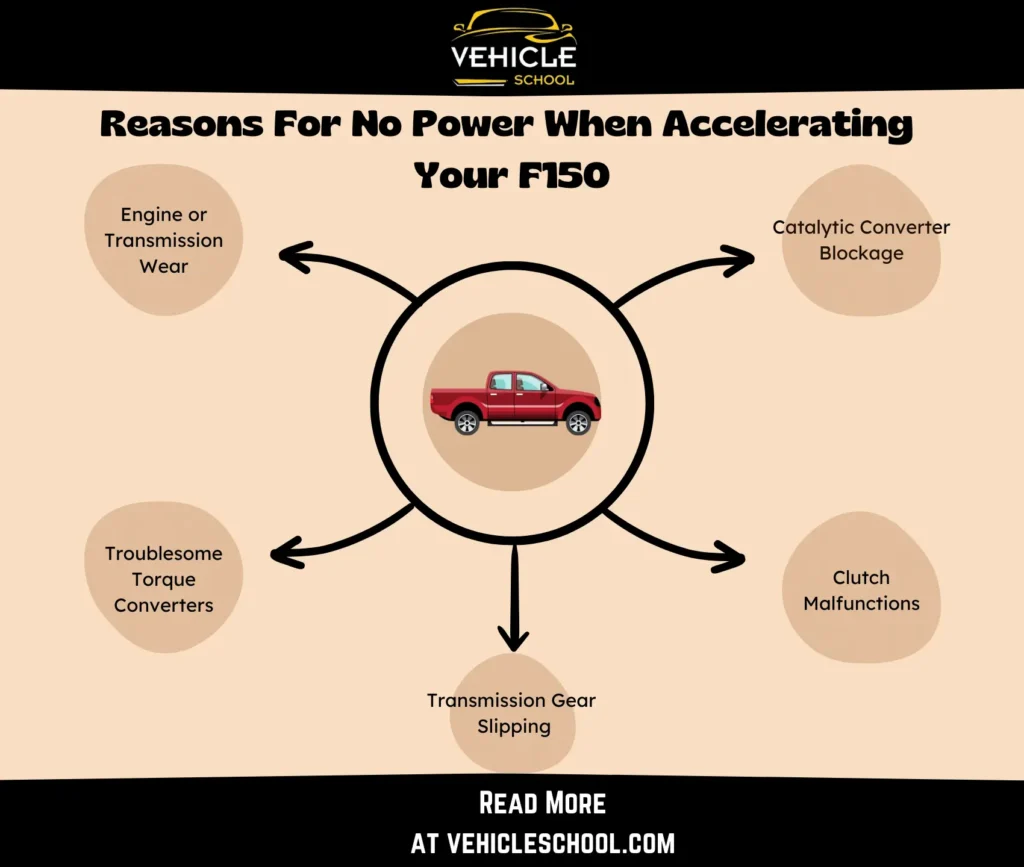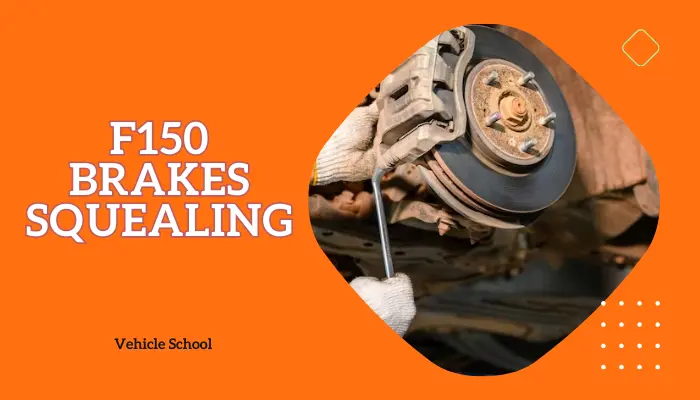Feeling low power while accelerating your Ford F150? It’s a common issue across models and years. But fret not, I’m here with the solutions.
I’ve shared some expert tips on how you can fix it so dive into the post for a complete breakdown of the issue.
why does my f150 lose power when accelerating?
If your Ford F-150 is not getting power during acceleration or feels sluggish, it could be a clogged catalytic converter, clutch trouble, or worn-out engine parts. You can fix this sluggish acceleration by swapping the converter, adjusting the clutch, or changing the torque converter. Also, switch transmission fluid, fix leaks, and do regular maintenance. If issues stick around, you’ll have to dig deeper into the engine.
Let’s go through why you’re having such troubles in detail before we get to fixing them, so you know what to keep an eye out for.

1. Blocked Catalytic Converter
Over time, the catalytic converter can get clogged up with dirt and exhaust gunk.
When this happens, it messes with the flow of exhaust gases, making it tough for the engine to do its thing during acceleration.
You’ll notice a lack of power, and some signs that your catalytic converter needs help include slower acceleration, darker-than-usual exhaust smoke, a smell like rotten eggs, the engine getting extra hot, and things just feeling a bit sluggish.
2. Clutch Is Malfuntioning
When your clutch isn’t in good shape, it messes with acceleration by not letting enough power reach the wheels.
Listen out for screechy noises, catch a whiff of something burning, feel the clutch slipping, or find that the pedal’s stuck—these are signs of a clutch in trouble.
The most common issue with F150s in this case is usually a misaligned clutch.
3. Engine or Transmission Wear
Wear and tear or a lack of maintenance can wear down your transmission or engine.
Worn-out parts mean power doesn’t transfer like it should, leading to a drop in acceleration.
Some drivers even face peculiar issues like their f150 won’t drive forward, only reverse, which could point to underlying ford f150 transmission problems.
If your transmission is messed up, you might notice low fluid levels, catch a whiff of something burning, experience sluggish performance, hear weird engine noises, or feel some shaking and grinding.
4. Torque Converters Has Gone Bad
Your torque converter can start acting up because it’s been through too much—maybe it’s overheated, dealing with funky fluids, or has some mechanical issues.
When it isn’t up to snuff, it messes with how power moves from the engine, leading to weak acceleration. Signs include an overheating system, shudders, a torque seal that’s seen better days, and dirty transmission fluid.
5. Transmission Gear Is Slipping
When gears slip, your truck will have a hard time keeping the power flowing smoothly.
Gears can get slippery for all sorts of reasons: they might be worn out, the gearbox could have faults, or the transmission fluid is not doing its job.
You may also hear a clunking noise or find a transmission leak. A flashing wrench light is a big giveaway for this issue.
How To Fix Ford F150 ecoboost no power when accelerating?
Now, here’s what you can do to take care of the F150 has no power issue:
1. Change The Catalytic Converter
- Jack your truck safely.
- Remove the exhaust screws.
- Take off the crosspiece, unplug the O2 sensors, and pull out the driveshaft.
- Unscrew and remove the gearbox mount.
- Detach the nuts connecting the converter to the exhaust.
- Disconnect the O2 sensors and take out the old converter.
- Get a new converter and fit new sensors.
- Hand-tighten nuts for new converters.
- Reinstall the mount, connect sensors, and secure the driveshaft.
- Put back the crosspiece, seal joints, and tighten screws.
- Lower the truck and check for leaks or sounds.
- Make sure everything is tight.
2. Realign The Clutch
- Locate the clutch friction plate and spigot bearing.
- Grab a clutch alignment tool with dowels.
- Pick-fitting dowels for the plate and bearing.
- Ensure a snug fit; tape up smaller dowels if needed.
- Check the friction plate’s directional cues.
- Insert the tool into the spigot bearing.
- Attach the pressure plate.
- Tighten bolts to the specified torque (e.g., 25 Nm).
- Remove the tool once the plate is secure.
- Proceed to fit the gearbox with everything aligned.
3. Replace Torque Converter
Below are the general steps for replacing Torque Converters for older F150 variants.
If you’ve got a model past 2010, look at your service manual to check if you need to make any extra adjustments.
- Remove the transmission.
- Extract the old torque converter by pulling it off.
- Get a compatible, new torque converter.
- Fill it with 2-3 quarts of recommended Ford synthetic transmission fluid.
- Allow bubbles to escape during filling.
- Confirm proper filling by checking the fluid level. Be prepared for the weight of the filled torque converter.
- Position it over the two shafts for installation.
- See if you get a “double clunk” as it slides onto both shafts.
- Check the correct installation by ensuring shafts are recessed inside the bell housing.
- Verify that the nubbies no longer stick out past the bell housing.
- The torque converter is now fully installed.
- Reinstall the entire assembly back into the vehicle.
4. Change Transmission Fluid
In my experience, swapping out the fluid or dealing with leaks (as per the steps of the next fix) are the best ways to deal with gear slippage.
- Remove the 19-mm bolt for the fill plug and dipstick access.
- Drain fluid by removing six bolts for smooth flow.
- Use aluminum foil to guide fluids and prevent spills.
- Clean the pan and check the magnet for metal shavings.
- Clean the gasket area, especially the edges.
- Clean the filter area with brake cleaner.
- Reinstall the pan, position the gasket, and tighten bolts (106 inch-pounds).
- Use Mercon LV fluid and pump until it pours from the fill hole.
- Start the engine, run for 15 minutes, and shift gears with your foot on the brake.
- Turn off, cool for 5 minutes, and check the fluid level with a dipstick.
- Clean spills, secure the plug and dipstick, and cool the area with a fan if needed.
- Perform final fluid check after cooling
5. Close Up Any Leaks
- Locate the transmission leak.
- Buy a new bulkhead fitting and filter.
- Loosen eight-millimeter bolts on the right front drive shaft.
- Drain transmission fluid by opening the dipstick plug.
- Remove the transmission pan and clean the magnet.
- Replace the bulkhead fitting and install the new filter.
- Reassemble the transmission pan and secure all bolts.
- Refill the transmission with ATF until it pours out.
- Check for starting issues or warnings on the gauge.
- Adjust the transmission harness if needed.
- Verify the fix by starting the truck and checking for issues.
6. Check The Engine And Transmission
I kept this as a last fix since it’s a much broader problem and a lot harder to figure out how to fix. Here’s a couple of general steps you can try:
- Top up low transmission fluid with the right type.
- Fix leaks and replace damaged parts causing fluid loss.
- Keep up regular maintenance for fluid and filter changes.
- Flush out the transmission entirely and refill.
- Grease up or replace worn moving parts for better performance.
If nothing works, the engine itself might be the issue – and that’s a more complicated deal.
You’ll have to start looking into a dedicated guide about engine issues or let a mechanic take a deeper look.
FAQs
Has there been any recall from Ford for the f150 engine shudder?
Yes, Ford recalled certain 2017-2020 F-150 models with the 21B10 engine due to an engine shudder issue. They offered a no-cost repair, including PCM reprogramming, for affected vehicles. If the shudder developed after the PCM update, there was a one-time no-cost repair to revert the PCM calibration to its original state.
Summing Up
A quick fix is all it takes to bring back the acceleration power in your F-150.
So, gear up, get hands-on, tackle all those issues, and soon you’ll be cruising in a high-powered, trouble-free beast.






